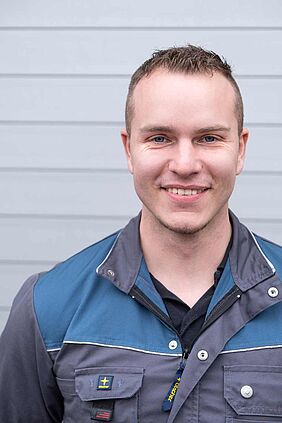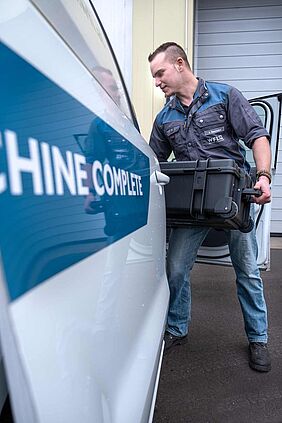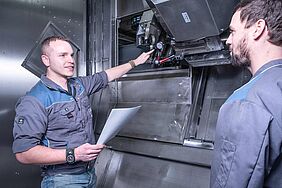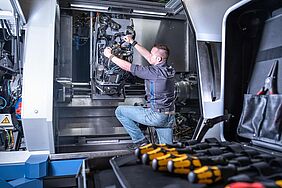
When and how did you start your career at WFL?
I began in August 2011. At first, my position was only ever intended to be a transitional solution. I worked at first in the Assembly, Pre-Assembly and Final Assembly departments. I then discovered that WFL also has a Service department and that the staff in this department travel around the globe. I was immediately fascinated by this, as I have always been excited by the idea of getting to know different countries, cultures and people. As such, I immediately applied for a position in the Service department and have now been working there since October 2012. My first year essentially comprised a detailed training phase. During this time, everyone works their way through Main Assembly and Commissioning, also receiving general training on control systems. This offers a perfect overview of the entire assembly process of a MILLTURN. Once I had completed this, I was already allowed to take my first business trip. My initial deployments were in Austria, Germany and Switzerland. The key here was to implement what I had learned in practice and to build on my specialist knowledge. The better you become, the further you are allowed to travel away from Linz. After two or three years, I was then finally sent out on global deployments.
What exactly does a typical service job look like?
This varies, depending on the job at hand. There are scheduled service jobs for which we generally know what to expect a long time in advance and then there are short-notice jobs. With the latter, we might arrive at work early in the morning and then have to take a flight to Malaysia that same afternoon. In terms of the workflow, the hotline is the first port of call for customers and the staff note down all the details: what needs to be done on the machine? As a service engineer, you then prepare yourself to work on the affected assemblies. You get hold of the corresponding plans, as well as special tools etc. As soon as the travel booking has been made, you are then ready to go.
So you always have your personal suitcase ready to go?
Exactly. The suitcase is always packed and ready for short-notice jobs.
How do you then proceed once you have arrived on the customer‘s premises?
After going through the sometimes lengthy and sometimes more straight-forward safety briefing, the contact person responsible then takes you to the actual machine. The customer then confirms what has been done on the machine. It is always important to question here whether the problem has been present for some time and how it started. After all, quite a few jobs – I would say around 10% – end up actually being a technological problem rather than a mechanical issue. Errors can easily occur when writing software, which then lead to vibrations or inaccuracies in terms of tolerances. When a problem occurs, it is often difficult for customers to determine what has ultimately caused it. It is therefore extremely important first of all to ask specific questions and gain a good overall picture of the situation. This makes it easier to select a suitable approach and get right to the heart of the issue. Steel is not just hard and cold, but also ductile and malleable. The material has its own dynamics, as even slight temperature differences caused by friction or similar during machining have a massive influence on the overall machining result. These things are the daily bread for service engineers like us. We always need to consider them.

What different types of service deployments are there?
The issues addressed during deployments range from sporadic problems such as vibrations, standstills, broken spindle bearings, overloaded axes and so on, through technical assistance, all the way up to retrofitting work. Regular deployments are always associated with the aforementioned sporadic problems. After all, service engineers can only accurately determine the issue once on site. This is done by checking the mechanical components, the programs, and compensation values to determine whether they are all correct.
When providing technical assistance, we make ourselves available to the customer should problems or questions arise. A deployment of this kind can last three months or longer, depending on the complexity. This service is ordered separately. When performing retrofit work, the first thing we do is perform a full survey of the customer‘s machine. We then order the parts and have them delivered to the customer. Although machines of this kind (typically over 20 years old) are still working, they are often in a condition that needs overhauling. All main components such as the turning-boring-milling unit, linear guide ways, main drive, tool changer, systems and so on, are replaced to improve the overall condition of the machine. A deployment of this kind takes between 6 and 8 weeks, sometimes even 10. It all depends on the size of the machine and the amount of time and effort required. During one deployment in Canada, for example, the only thing left over from the original machine was the shell, as everything else was completely replaced. This was certainly one of the most challenging jobs. Our motto in Service is: once you head out for a job, you do not leave until the work has been completed and the problem 100% fixed.
What resources are used?
We use special equipment such as clamping force measuring devices, endoscopes, lasers for straightness testing, and also things like digital measuring equipment for checking geometry and so forth. But as a general rule, the machine‘s control system is the best test instrument, as it allows you to filter out all other problems. If you know what you are doing with the control system, you have already won half the battle.
Do you also offer brief training once you have completed the repair work? If so, how does this work?
Customers very often come to us and ask what they can do to ensure that their machine still has a long life cycle ahead of it. Of course, the top priority here is to keep the machine clean and ensure that all annual maintenance work is performed as stipulated in the operation manual.
What difficulties do you experience when performing service work?
When you are in countries such as China, India or Russia, the first hurdle is the language. This often makes it more difficult to provide customers with clear instructions. If you are the first one on the scene, for example following a machine collision, you can often find yourself in the firing line of criticism. In situations like these, the most important thing is to stay calm and not take things personally. Although you are clearly always dealing with problems, it is a great feeling if you can sort out the issues and then end the job on a positive note.
Do you also regularly chat with colleagues from the Service or Technology departments while you are out on service deployments?
Yes, that happens. For example if you are confronted with software problems or need to request plans so that you can complete the necessary work. You generally get in touch with the Service Hotline in situations like this. The office staff then provide the necessary documentation, so that the work can be performed as effectively and smoothly as possible. The flow of information at WFL is always excellent in this regard.
How would you describe the ideal service deployment?
For an ideal service deployment, you should already know the problem in advance. This allows you to prepare yourself accordingly and you do not need to first localise the issue. You know exactly what needs to be done. Unfortunately, this does not happen very often. The simplest job I ever had was to replace an S1 motor. I already knew where the problem was, what to expect and how I needed to proceed.
What has changed since you first started going out on service deployments?
One new thing is our S.A.M app (Service - Application - Manager). When you are on site with the customer, this can be used to scan a QR code and determine which spare parts are required. Travel expenses are also recorded using the app. When a job is complete, the receipts are automatically sent to our office. The office can then draw up the invoice promptly and does not have to physically wait for the documents to see what has been booked.
Are there any service deployments that really stick in your mind?
The extremely strict and time-consuming security searches encountered in certain countries always stick in my memory. Otherwise, I found Norway particularly impressive. These have always been good trips in terms of how smoothly everything has gone on the ground. The customers have also always been attentive and keen to learn. It is fair to say that I am really fascinated by Norway, its culture, its people and its landscape.
You have also been involved in service training since 2019. What tasks do you currently perform here?
I am responsible for training our overseas service engineers. My colleague Bruno K. looks after the Austrian engineers. I also occasionally help out with customer training sessions if we are short on staff. What does this kind of training involve? It starts with evaluating the current level of knowledge of the respective engineers. I then compile the training programme on this basis. This is very well received by our colleagues, as we can focus on the topics where further knowledge is required. The fact that we typically provide one-to-one training is also beneficial, as this obviously offers the best possible learning outcomes. This concept really works well. The training typically takes between 4 and 6 weeks.
How would you describe the Service department at WFL?
The Service department at WFL excels in particular through its response times. We are able to perform repairs particularly quickly for all components in the machine, not just for individual assemblies. Our customers really appreciate this.

Sharing knowledge and learning new things is the motivation.















